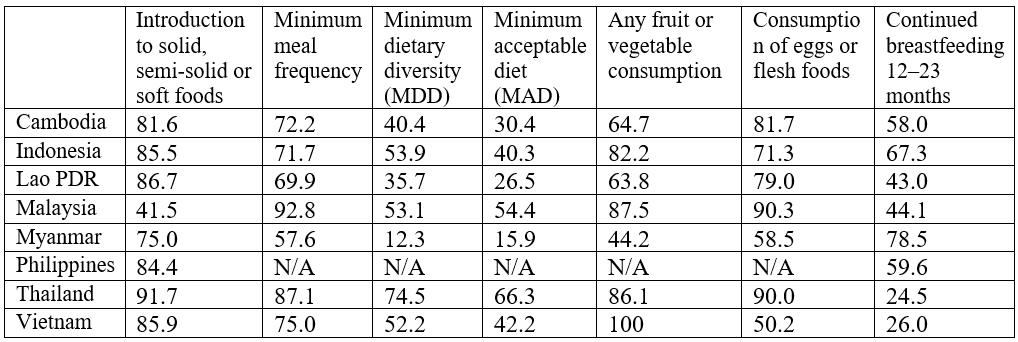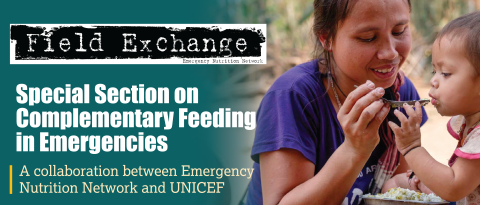Regional Perspective: East Asia and Pacific
Jessica Blankenship is a Regional Nutrition Specialist in UNICEF’s East Asia and Pacific Regional Office (EAPRO), specialising in maternal, infant and young child nutrition
Roland Kupka is the Regional Nutrition Advisor at UNICEF EAPRO
Despite substantial economic growth in Southeast Asia, the triple burden of malnutrition – undernutrition, hidden hunger (due to vitamin and mineral deficiencies) and overweight – continues to threaten the survival, growth and development of young children. At least one in four children under the age of five in Southeast Asia suffers from one or more of the most visible forms of malnutrition, with 27.4% being stunted, 8.2% wasted and 7.5% overweight (UNICEF et al., 2021).
A major driver of child malnutrition in Southeast Asia is inadequate child complementary feeding practices. UNICEF EAPRO conducted a landscape analysis on complementary feeding in Cambodia, Indonesia, Lao PDR, Myanmar, the Philippines and Vietnam 2018–2019 (UNICEF EAPRO, 2021). This showed that, while complementary feeding is included in national nutrition policies, practices are inadequate across the region. Specifically, children’s diets lack diversity and they are not fed frequently enough to meet their growth and development requirements (Table 1).
Table 1. Complementary feeding practices in children aged 6–23 months in Southeast Asia (ANSS, 2022)

N/A: data not available. Many of the values presented were reanalysed by UNICEF to reflect the recently updated definitions for complementary feeding indicators published in 2021. As a result, they may differ slightly from previous indicator estimates printed in older reports.
The barriers to meeting the nutrient needs of young children are uniquely challenging in Southeast Asia as the context is changing dynamically. More families are moving to cities and their diets are constrained due to poverty, inequities and the increasing cost of nutritious foods. More women are participating in the workforce, often while continuing to carry the greatest burden of caregiving and household duties, restricting the time they have to prepare healthy homemade foods for their children (and for themselves). Families are shifting from traditional diets towards convenient processed foods, which are usually higher in salt, sugar and fat and low in essential nutrients (UNICEF, 2019).
From 2018 to 2019, UNICEF EAPRO hosted a series of regional and country-level technical consultations to identify priority actions. Regional frameworks (Figure 1) were developed to outline a comprehensive set of overarching and multi-sector strategic actions across the health, food, education, social protection, and water, sanitation and hygiene (WASH) systems to improve complementary feeding.
Figure 1. Southeast Asia Regional Action Framework for Complementary Feeding
UNICEF EAPRO supported countries to adapt the regional Action Frameworks through the development of the Association of Southeast Asian Nations (ASEAN) Food and Nutrition Security Report in 2021 (ASEAN et al., 2022). This provided an overview of the food and nutrition security profiles of countries in ASEAN member states, detailed the progress made over the previous five years and made recommendations on the way forward. UNICEF EAPRO also supported the development of a series of six ASEAN guidelines and documents on minimum standards – including one on the protection, promotion and support of breastfeeding and complementary feeding (ASEAN et al., 2022) – and the ASEAN Nutrition Surveillance System (ANSS) to annually monitor and report against 104 nutrition-specific and nutrition-sensitive indicators.1
Three research and knowledge gaps were also identified from the priority actions, as follows.
The role of nutrition-sensitive social protection: UNICEF EAPRO has developed a policy working paper documenting opportunities to expand social protection pathways to nutrition (UNICEF, 2020). A series of surveys have also been conducted on the status and determinants of food insecurity and undernutrition in the urban poor in Indonesia (UNICEF, FAO, WFP, & WHO, 2021a), the Philippines (UNICEF, FAO, WFP, & WHO, 2021b) and Myanmar (UNICEF, FAO, WFP, & WHO, 2021c), with the Food and Agricultural Organization (FAO) and World Food Programme (WFP), particularly focused on the impact of the COVID-19 pandemic.
Strengthening capacity for the development and implementation of social behaviour change (SBC) strategies: Despite being a priority overarching action in the region, there has been limited at-scale and sustained delivery of SBC strategies to improve nutrition. In 2021, UNICEF EAPRO conducted a capacity assessment in Cambodia, Lao PDR and the Philippines, which led to the development of a training curriculum on nutrition SBC for government staff to support planning, budgeting, management and monitoring of strategies and programmes at the national and sub-national levels.
Development of standards and a nutrient profile and labelling model for the promotion of commercially available complementary foods (CACFs) for children aged 6–36 months: Families in Southeast Asia increasingly rely on CACFs due to convenience and time constraints. CACFs vary widely in nutritional quality (Bassetti et al., 2022): they may either provide critical micronutrients that are limited in the diets of infants and young children, or they may lack fortification and/or contain high levels of added salt, sugar or unhealthy fats. While both the World Health Organization (WHO) and UNICEF recommend the use of fortified CACF in some circumstances, the regional and national standards regulating their promotion in Southeast Asia are insufficient. The Southeast Asia Consortium for Improving Complementary Foods (COMMIT) was formed by regional nutrition partners to fill evidence gaps on nutrient composition and labelling of CACFs in Cambodia, Indonesia, Laos PDR, Malaysia, the Philippines, Thailand and Vietnam, and to develop recommendations to strengthen national standards and guide the adaptation of a nutrient profile and labelling model at the national level.
Next steps
UNICEF EAPRO continues to support a systems-based, holistic approach to improving the diets of infants and young children through assisting governments to identify and implement evidence-based priority actions for complementary feeding. Technical assistance will be provided to strengthen national capacity for nutrition-sensitive social protection and development and the implementation of SBC strategies for nutrition, as well as the adaptation of the COMMIT regional framework to guide national CACF standards.
For more information, please contact Jessica Blankenship at jblankenship@unicef.org.
References
ANSS (2022) ASEAN Nutrition Surveillance System (ANSS). ASEAN. https://asean-anss.org/
ASEAN, UNICEF, & Alive & Thrive (2022). Guidelines and Minimum Standards for the Protection, Promotion and Support of Breastfeeding and Complementary Feeding. ASEAN, UNICEF, & Alive & Thrive https://www.unicef.org/eap/reports/guidelines-and-minimum-standards-breastfeeding
ASEAN, UNICEF, & WFP (2022) ASEAN Food and Nutrition Security Report 2021, Vols 1 & 2. United Nations Children’s Fund https://www.unicef.org/eap/reports/asean-food-and-nutrition-security-report-2021
Bassetti E , Zehner E, Mayhew S et al (2022) Nutrient profiles of commercially produced complementary foods available in Cambodia, Indonesia, and the Philippines. Public Health Nutrition, 25, 10, 1–28.
Blankenship J, Rudert C & Aguayo V (2021) Triple trouble: Understanding the burden of child undernutrition, micronutrient deficiencies and overweight in East Asia and the Pacific. Maternal & Child Nutrition, 16(S2), e12950. https://doi.org/10.1111/mcn.12950
UNICEF (2019) The State of the World’s Children 2019. Children, Food and Nutrition: Growing Well in a Changing World. United Nations Children’s Fund.
UNICEF (2020) The Social Protection Pathways to Nutrition: A Stocktaking of Evidence in Asia and the Pacific. United Nations Children’s Fund https://socialprotection.org/discover/publications/social-protection-pathways-nutrition-stocktaking-evidence-asia-and-pacific
UNICEF EAPRO (2021) Southeast Asia Regional Report on Maternal Nutrition and Complementary Feeding. United Nations Children’s Fund https://www.unicef.org/eap/reports/maternal-nutrition-and-complementary-feeding
UNICEF, FAO, WFP, & WHO (2021a) Food Security and Nutrition in Urban Indonesia: Evidence from a Remote COVID-19 Survey. UNICEF, FAO, WFP, & WHO
UNICEF, FAO, WFP, & WHO (2021b) Food Security and Nutrition in Urban Philippines: Evidence from a Remote Follow-Up Survey. UNICEF, FAO, WFP, & WHO
UNICEF, FAO, WFP, & WHO (2021c) Food Security and Nutrition in Urban Yangon: Evidence from a Remote Follow-Up Survey. UNICEF, FAO, WFP, & WHO
UNICEF, WHO, & IBRD/World Bank (2021) Levels and Trends in Child Malnutrition: Key Findings of the 2021 Edition of the Joint Child Malnutrition Estimates. UNICEF, WHO, & IBRD/World Bank



